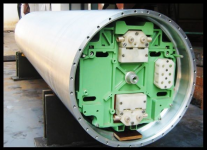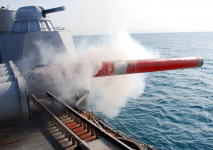That's the design of the Jalastra? Looks very similar to the ALWT, especially the pump jet propulsion set up. Check ALWT pics on page 1 of this thread.
Indian Sonar and Torpedo developments
- Thread starter hellbent
- Start date
-
- Tags
- drdo indian navy
You are using an out of date browser. It may not display this or other websites correctly.
You should upgrade or use an alternative browser.
You should upgrade or use an alternative browser.
NSTL has a tender for supply of 5 units of Li-ion battery packs with battery management system:


So each battery pack has 13 cell & each cell can produce 480 W of electric power. Thus total power is (480 x 13)= 6240 W = 6.24 kW
This new Li-ion battery is a lab scale test battery. This is the 1st time we willbe using Li-ion batteries to underwater applications. For comparison the Silver Oxide Zinc battery used on the ALWT has 70 kW power. The Varunastra has 250 W Silver Oxide Zinc battery.
The submarine launched version of the Varunastra (called the EHWT) with have an upgraded 300 kW Silver Oxide Zinc battery. That battery is under prototype testing:

Maybe a scaled up version of the Li-ion battery can be used on the upcoming Jalastra torpedo.


So each battery pack has 13 cell & each cell can produce 480 W of electric power. Thus total power is (480 x 13)= 6240 W = 6.24 kW
This new Li-ion battery is a lab scale test battery. This is the 1st time we willbe using Li-ion batteries to underwater applications. For comparison the Silver Oxide Zinc battery used on the ALWT has 70 kW power. The Varunastra has 250 W Silver Oxide Zinc battery.
The submarine launched version of the Varunastra (called the EHWT) with have an upgraded 300 kW Silver Oxide Zinc battery. That battery is under prototype testing:

Maybe a scaled up version of the Li-ion battery can be used on the upcoming Jalastra torpedo.
NSTL has a tender for supply of 5 units of Li-ion battery packs with battery management system:
The above packs are for ALWT. They seem to be revising the design again. The other project with Lithium packs is the HEAUV (High Endurance Autonomous Underwater Vehicle). Very high activity in the HEAUV tenders nowadays.
Is is good enough to substitute the rejected torpedo import due to corruption charges.
No lesser range and speedIs is good enough to substitute the rejected torpedo import due to corruption charges.
Won't the submarine performance suffer?No lesser range and speed
Why would it suffer? The torpedo is above average but not the best..Won't the submarine performance suffer?
If they could get economy of scale and batch by batch improvements. It will be a quite a successful export product. But we need a torpedo in the class of the British spearfish.
Have some shame DRDO. Where is our towed array sonar?
Look closely you may see made in China written all over it.
Have some shame DRDO. Where is our towed array sonar?
Does it matter? When their ships have towed sonars and ours don't. Atleast 15 or so ships sailing without it.Look closely you may see made in China written all over it.
A Kerala gov psu Keltron showed these at defexpo
DRDO launches sonar systems test and evaluation facility for Indian Navy
The facility is named as Hull Module of Submersible Platform for Acoustic Characterisation and Evaluation (SPACE).DRDO launches sonar systems test and evaluation facility for Indian Navy (nov.08)
India’s Defence Research and Development Organisation (DRDO) has launched a new testing and evaluation facility for sonar systems of the Indian Navy.
Announced by the Indian Ministry of Defence (MoD), the new facility is now operational at DRDO’s Naval Physical and Oceanographic Laboratory (NPOL) in Kochi, Kerala, India.
This newly launched facility is named as Hull Module of Submersible Platform for Acoustic Characterisation and Evaluation (SPACE).
The design of this facility is based on the concept, design and requirements proposed by the NPOL.
The SPACE facility will primarily test and assess sonar systems aboard different types of naval vessels, such as submarines, warships and maritime aircraft or helicopters.
The centre will also allow rapid deployment and easy recovery of other scientific packages, including transducers and sensors.
The new ‘one-of-a-kind’ facility is a submersible platform that can reach up to the depths of around 100m.
In a statement, Indian MoD said: “The uniqueness of this facility lies in the specially designed submersible platform, which can be lowered up to depths of 100m using a series of synchronously operated winches.”
The SPACE facility has been constructed by the Indian company Larsen & Toubro (L&T) Shipbuilding in Chennai.
According to the MoD, the design and construction of the SPACE facility complies to all the statutory needs and requirements of the Indian Register of Shipping.
Furthermore, the platform also adheres to the needs of the vessel classifying authority as well as the inspection and registration criteria set by the Kerala Inland Vessel Rules.
This new facility has further boosted the Government of India’s ‘AatmaNirbhar Bharat’ and ‘Make in India’ initiatives.
Earlier this year, the MoD contracted L&T to build two multi-purpose vessels for the service.

CAG flags DRDO declaring 20 mission mode projects ‘successful’ despite not achieving objectives
Between January 2010 and December 2019, the DRDO had closed 103 mission mode (MM) projects, undertaken on proven and readily accessible technologies, after incurring an expenditure of ₹2,505.23 crore, says CAG
There you go, update on ALTAS. They closed the project.

In short we will continue to import towed sonar.
CAG flags DRDO declaring 20 mission mode projects ‘successful’ despite not achieving objectives
Between January 2010 and December 2019, the DRDO had closed 103 mission mode (MM) projects, undertaken on proven and readily accessible technologies, after incurring an expenditure of ₹2,505.23 crore, says CAGwww.thehindubusinessline.com
There you go, update on ALTAS. They closed the project.
That's not the worst part. They block import for a never coming Indian sonar and navy continue to be handicapped.In short we will continue to import towed sonar.
Import should be done when it's needed.
Npol is having very bad track record when it comes to towed sonar.That's not the worst part. They block import for a never coming Indian sonar and navy continue to be handicapped.
Import should be done when it's needed.





